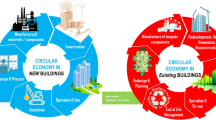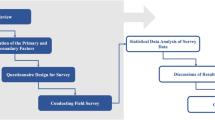Abstract
Addressing urban housing crisis is an enormous challenge for most of the countries due to the increasing cost of the building material. Therefore, affordable alternative building material can make a breakthrough to the urban housing crisis. In the light of current success of stabilised earth construction in urban low-cost housing, it is important to find out the potential drivers that can help to adopt this building material. This paper aims to identify and highlight these drivers from the method of literature review and validates through a Delphi technique.






Similar content being viewed by others
References
Abey, J., & Smallcombe, J. (2007). Cob in contemporary architecture. In International symposium on earthen structures, Indian institute of science, Bangalore, 22–24 August. India: Interline Publishing.
Adam, E. A., & Agib, A. R. A. (2001). Compressed Stabilised Earth Block Manufacture in Sudan. Printed by Graphoprint for the United Nations Educational, Scientific and Cultural Organization. France, Paris: UNESCO.
Adams, C. (2005). The realities of specifying environmental building materials. In L. Elizabeth & C. Adams (Eds.), Alternative construction: contemporary natural building methods. New York, USA: Wiley.
Adler, M., & Ziglio, E. (1996). Gazing into the oracle: The Delphi method and its application to social policy and public health. London: Jessica Kingsley Publishers.
Andranovich, G. (1995). Developing community participation and consensus: The Delphi technique. In Partnerships in education and research, WREP 131. Los Angeles: Department of Political Science, California State University. C:\DocumentsandSettings\pzp005\My Documents\PhD Papers\The Delphi Interview 01.mht, June 23, 2008.
Baiche, B., Osmani, M., Hadjri, K., & Chifunda, C. (2008). Attitude towards earth construction in the developing world: a case study from Zambia. In CIB W107 Construction in Developing World Countries International Symposium. “Construction in Developing countries: Procurement, Ethics and Technology.” January 16–18, 2008, Trinidad and Tobago, West Indies.
Blondet, M., & Aguilar, R. (2007). Seismic protection of earthen buildings. In International Symposium on Earthen Structures, Indian Institute of Science, Bangalore, 22–24 August. India: Interline Publishing.
Castells, S. B., & Laperal, E. H. (2007). Spanish architects working on earth. In International Symposium on Earthen Structures, Indian Institute of Science, Bangalore, 22–24 August. India: Interline Publishing.
Czinkota, M., & Ronkainen, I. A. (1997). International business and trade in the next decade: Report from a Delphi study. Journal of International Business Studies, 28(4), 827–844.
Delbeq, A., Van de Ven, A., & Gustafson, D. H. (1975). Group techniques for program planning: A guide to nominal group and Delphi processes. Glenview, USA: Scott, Foresman and Company.
Easton, D. (1996). The rammed earth house. White River Junction, Vermont, USA: Chelsea Publishing Company.
Eisenberg, D. (2005). A new context for building codes and regulation. In L. Elizabeth & C. Adams (Eds.), Alternative construction: Contemporary natural building methods. New York, USA: Wiley.
Elizabeth, L. (2005). The natural building movement. In L. Elizabeth & C. Adams (Eds.), Alternative construction: Contemporary natural building methods. New York, USA: Wiley.
Hadjri, K., Osmani, M., Baiche, B., & Chifunda, C. (2007). Attitude towards earth building for Zambian housing provision. In Proceedings of the ICE Institution of Civil Engineers, Engineering Sustainability 160, issue ES3.
Helmer, O. (1983). Looking forward: A guide to futures research. Beverly Hills: Sage Publications.
Houben, H. et al. (2007). Innovative approaches in educational pedagogy for earthen architecture. In International Symposium on Earthen Structures, Indian Institute of Science, Bangalore, 22–24 August. India: Interline Publishing.
Houben, H., & Guillaud, H. (1994). Earth construction, a comprehensive guide. London, UK: Intermediate Technology Publications.
Jagadish, K. S. (2007). Earth construction today: prospects and tasks. In International Symposium on Earthen Structures, Indian Institute of Science, Bangalore, 22–24 August. India: Interline Publishing.
Jayashinghe, C. (2007). Characteristics of different masonry units manufactured with stabilized earth. In International Symposium on Earthen Structures, Indian Institute of Science, Bangalore, 22–24 August. India: Interline Publishing.
King, B. (1996). Buildings of earth and straw: Structural design for rammed earth and straw-bale architecture. California, USA: Ecological Design Press.
Lal, A. K. (1995). Handbook of low cost housing. New Delhi, India: New Age International Publishers.
Linstone, H., & Turoff, M. (1975). “Introduction” in the Delphi method: Techniques and applications. In H. Linstone & M. Turoff (Eds.) London: Addison-Wesley Publishing Company.
Maini, S. (2005). Earthen architecture for sustainable habitat and compressed stabilised earth block technology. In Progrmmae of the city on heritage lecture on clay architecture and building techniques by compressed earth, high commission of Ryadh City development. India: The Auroville Earth Institute, Auroville Building Centre.
Maini, S. (2007). Earthen architecture and stabilised earth techniques in Auroville, India. In International Symposium on Earthen Structures, Indian Institute of Science, Bangalore, 22–24 August. India: Interline Publishing.
Maniatidis, V., & Walker, P. (2003). A review of rammed earth construction for DTi partners in innovation project ‘Developing Rammed Earth for UK Housing’. United Kingdom: Natural Building Technology Group, Department of Architecture and Civil Engineering, University of Bath.
Minke, G. (2006). Building with earth, design and technology of a sustainable architecture. Basel, Berlin, Boston: Birkhauser Publishers for Architecture.
Morton, T. (2007). Towards the development of contemporary Earth Construction in the UK: Drivers and benefits of Earth Masonry as a Sustainable Mainstream Construction Technique. In International Symposium on Earthen Structures, Indian Institute of Science, Bangalore, 22–24 August. India: Interline Publishing.
Mubaiwa, A. (2002). Earth as an alternative building material for affordable and comfortable housing in Zimbabwe: Undergraduate Dissertation. Department of Architecture, National University of Science and Technology, Bulawayo, Zimbabwe.
Norton, J. (1997). Building with earth: A handbook (2nd ed.). London, UK: Intermediate Technology Publications.
Rowe, G., & Wright, G. (1999). The Delphi technique as a forecasting tool: Issues and analysis. International Journal of Forecasting, 15(4), 353–375.
Skulmoski, G. J., Hartman, F. T. and Krahn, J. (2007). The Delphi method for graduate research. Journal of Information Technology Education, 6.
Zami, M. S. (2010). Understanding the factors that influence the adoption of stabilised earth by construction professionals to address the Zimbabwe urban low cost housing crisis. PhD thesis submitted to University of Salford, United Kingdom.
Zami, M. S., & Lee, A. (2008). Constraints of earth construction Zimbabwe—some possible solutions. In The 8th International Postgraduate Research Conference. June 26–27, 2008, Czech Republic: The Czech Technical University of Prague (CVUT).
Zami, M. S., & Lee, A. (2010). Influence of contemporary earthen architecture on environmental sustainability in the United Kingdom. In CIB World Congress 2010. May 10th–13th, Salford Quays, United Kingdom: The Lowry.
Zami, M. S., & Lee, A. (2010). Inhibitors influencing the adoption of contemporary earth construction in the United Kingdom—state of the art review. In CIB World Congress 2010. May 10th–13th, Salford Quays, United Kingdom: The Lowry.
Author information
Authors and Affiliations
Corresponding author
Additional information
Readers should send their comments on this paper to BhaskarNath@aol.com within 3 months of publication of this issue.
Rights and permissions
About this article
Cite this article
Zami, M.S. Drivers that help adopting stabilised earth construction to address urban low-cost housing crisis: an understanding by construction professionals. Environ Dev Sustain 13, 993–1006 (2011). https://doi.org/10.1007/s10668-011-9301-0
Received:
Accepted:
Published:
Issue Date:
DOI: https://doi.org/10.1007/s10668-011-9301-0




